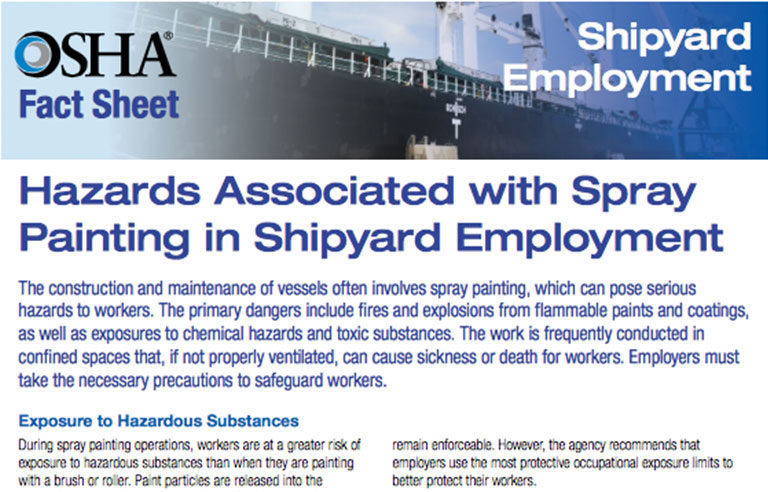OSHA releases fact sheet on spray painting in shipyards

Washington – A new fact sheet from OSHA is intended to protect shipyard workers from hazards associated with spray painting.
Fires and explosions from flammable paints and coatings, as well as exposure to chemical hazards and toxic substances, are the primary dangers shipyard workers face, according to the fact sheet. Improper ventilation in confined spaces poses additional risk for illness or death.
“Shipyard employers are responsible for identifying, evaluating and protecting workers from exposure to respiratory and other hazards in the workplace,” the resource states. “Where appropriate, employers must ensure chemical labels and Safety Data Sheets are made available to exposed workers, and train them on the hazards and measures necessary to protect themselves.”
The fact sheet includes numerous tips:
- Ensure workers use appropriate personal protective equipment such as protective clothing, gloves, goggles and face shields to prevent paint coatings from coming into contact with a worker’s face, eyes, head, hands, feet and other exposed skin.
- Have a “shipyard competent person” perform frequent atmospheric tests to ensure solvent vapors remain at a concentration level below 10 percent of the lower explosive limit.
- Follow guidelines to ensure tools and equipment do not serve as ignition sources in flammable and combustible atmospheres. For areas in which paints or coatings have flash points below 80° F, ensure all tools are electrically bonded or grounded to the vessel, preventing static discharge.
- Do not bring ferrous materials into work areas, and assemble staging and scaffolding in a non-sparking setup.
- Provide fire extinguishing equipment in work areas, and train workers to recognize fire hazards and to follow a facility’s fire safety plan.
- Continue using ventilation after painting operations are complete while keeping the space gas-free. Once ventilation has been stopped, retest the atmosphere after 10 minutes.
Post a comment to this article
Safety+Health welcomes comments that promote respectful dialogue. Please stay on topic. Comments that contain personal attacks, profanity or abusive language – or those aggressively promoting products or services – will be removed. We reserve the right to determine which comments violate our comment policy. (Anonymous comments are welcome; merely skip the “name” field in the comment box. An email address is required but will not be included with your comment.)

